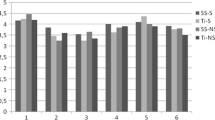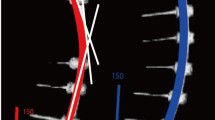Abstract
Pullout of the cranial end-vertebra screw following the correction of a scoliosis with the VDS implant is a common complication. Very little is known about the forces acting on the screws during ventral derotation spondylodesis (VDS) in ventral scoliosis surgery. These forces determine the risk of screw-loosening. The purpose of this study was to identify implant properties and to determine surgical correction strategies that reduce the risk of cranial end-vertebra screw pullout. For this aim, a three-dimensional nonlinear finite element model of a scoliotic thoracic spine was created with a Cobb angle of 61° and 32° rotation. The VDS implant was inserted between T5 and T9. The longitudinal rod diameter, the implant material and seven surgical correction strategies were examined to determine their influence on the Cobb angle as well as on derotation and on axial and transverse forces in the screws. A stiffer implant achieves a better correction but causes higher axial and transverse screw forces. Axial tensile forces act on the screws fixed to the cranial end vertebra and the middle vertebra, while axial compressive forces act on the other screws. A strong correction at the cranial segment leads to high axial and transverse screw forces in the farthest cranial screw and thus to a high risk of screw pullout. The resultant transverse force is often much higher than the axial force component. Simulation of local trunk muscle forces has only a minor effect on the results. The axial tensile forces and thus the risk of screw pullout are highest at the cranial end vertebra. A strategy in which surgical correction is strong in the middle segments and moderate in the outer ones leads to a good reduction of the Cobb angle, a wide derotation angle, and relatively low axial tensile forces at the cranial end vertebra screw.








Similar content being viewed by others
References
Eysel P, Schwitalle M, Oberstein A, Rompe JD, Hopf C, Kullmer K (1998) Preoperative estimation of screw fixation strength in vertebral bodies. Spine 23:174–180
Goel VK, Monroe BT, Gilbertson LG, Brinckmann P (1995) Interlaminar shear stresses and laminae separation in a disc. Finite element analysis of the L3-L4 motion segment subjected to axial compressive loads. Spine 20:689–698
Halm H (2000) Ventrale und dorsale korrigierende und stabilisierende Verfahren bei idiopathischer Skoliose. Orthopäde 29:543–562
Hopf C (2000) Kriterien zur Behandlung idiopathischer Skoliosen zwischen 40° und 50°. Operative vs. konservative Therapie. Orthopäde 29:500–506
Klöckner C, Walter G, Matussek J, Weber U (2000) Ventrodorsale Korrektur und Instrumentation idiopathischer Skoliosen. Orthopäde 29:571–577
Moe J, Purcell G, Bradford D (1983) Zielke Instrumentation (VDS) for the Correction of Spinal Curvature. Clin Orthop 180:133–153
Oda I, Abumi K, Cunningham BW, Kaneda K, McAfee PC (2002) An in vitro human cadaveric study investigating the biomechanical properties of the thoracic spine. Spine 27:E64–E70
Ogon M, Haid C, Krismer M, Sterzinger W, Bauer R (1996) Comparison between single-screw and triangulated, double-screw fixation in anterior spine surgery. A biomechanical test. Spine 21:2728–2734
Panjabi MM, Brand RA, White III AA (1976) Mechanical Properties of the Human Thoracic Spine. J Bone Joint Surg Am 58-A:642–652
Patwardhan AG, Havey RM, Meade KP, Lee B, Dunlap B (1999) A follower load increases the load-carrying capacity of the lumbar spine in compression. Spine 24:1003–1009
Rohlmann A, Neller S, Claes L, Bergmann G, Wilke H-J (2001) Influence of a follower load on intradiscal pressure and intersegmental rotation of the lumbar spine. Spine 26:E557–E561
Rohlmann A, Zander T, Bergmann G (2005) Effect of total disc replacement with ProDisc on the biomechanical behavior of the lumbar spine. Spine 30(7):738–743
Shirazi-Adl A, Ahmed AM, Shrivastava SC (1986) Mechanical response of a lumbar motion segment in axial torque alone and combined with compression. Spine 11:914–927
Zander T, Rohlmann A, Calisse J, Bergmann G (2001) Estimation of muscle forces in the lumbar spine during upper-body inclination. Clin Biomech 16:S73–S80
Zielke K, Stunkat R, Duquesne J, Beaujean F (1975) Ventrale Derotationsspondylodese. Orthopädische Praxis 11:562–569
Acknowledgements
Finite element analyses were performed at the Norddeutscher Verbund für Hoch- und Höchstleistungsrechnen (HLRN) and the Zentraleinrichtung Rechenzentrum Berlin (ZRZ). The authors thank Dr. J.Weirowski for editorial assistance.
Author information
Authors and Affiliations
Corresponding author
Rights and permissions
About this article
Cite this article
Rohlmann, A., Richter, M., Zander, T. et al. Effect of different surgical strategies on screw forces after correction of scoliosis with a VDS implant. Eur Spine J 15, 457–464 (2006). https://doi.org/10.1007/s00586-005-0923-5
Received:
Revised:
Accepted:
Published:
Issue Date:
DOI: https://doi.org/10.1007/s00586-005-0923-5




